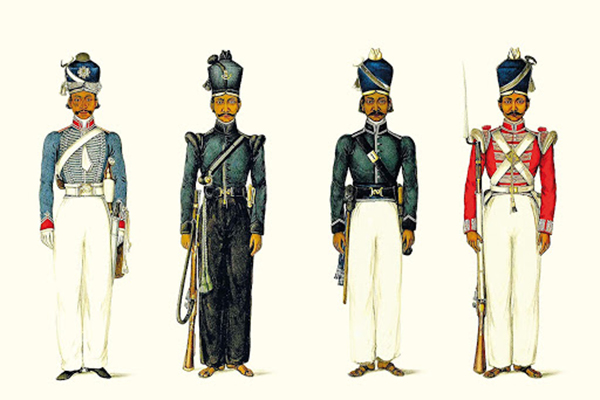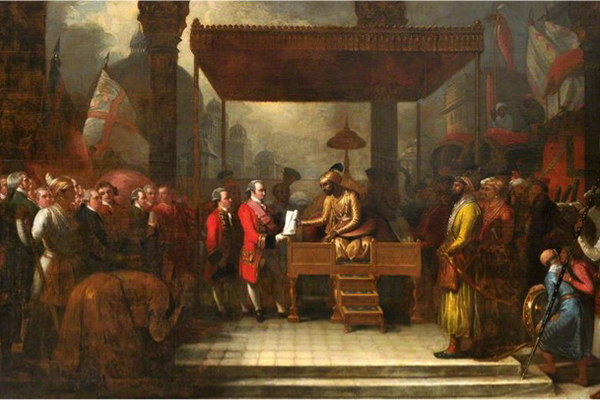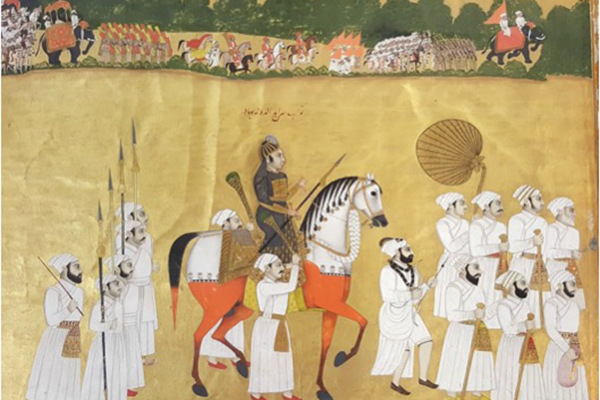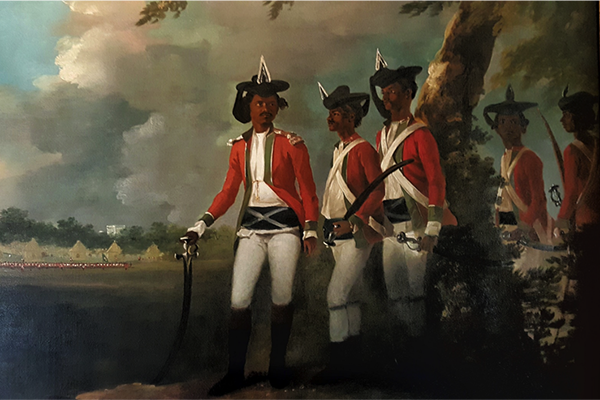
William Dalrymple’s latest book is a gripping tale of the East India Company, the world’s first multinational corporation
In the 18th century, within a span of less than 50 years, The East India Company, the world’s first multinational corporation, seized India and become the de facto ruler of the country while maintaining the powerless and vanquished Mughal Emperor Shah Alam as its figurehead: the Company preferred to “infiltrate” the system rather than “blowing it apart.” By this time, the Company generated half of Britain’s trade; its annual spending in Britain alone equaled a quarter of the entire British government’s expenditure: its army was larger than almost all nation states; and it had created a sophisticated civil and administrative service.
William Dalrymple’s new book The Anarchy: The Relentless Rise of the East India Company takes a look at this crucial period in history. He explores how and why the East India Company, which had established trading posts in India in the 17th century, attained such eminence as an imperial power over 100 years later and defeated its main rivals. This “conquest of India” was particularly unusual because it was the achievement, not of a government or a nation state, but an “unregulated,” ruthless and competitive corporation with the sole aim of “enriching its investors;” this wealth, in turn, profoundly influenced Parliament in the Company’s favor.

Shah Alam conveying the gift of the Diwani to Lord Clive by Benjamin West. Courtesy British Library
Dalrymple reconstructs the complex and intricate tale of 18th century India and Britain with great skill, both as a historian and a storyteller. His narrative traverses the subcontinent to tell of decisive battles, personal and political rivalries, human flaws and incidents of chance that determined the future. He brings to life a myriad of historical characters pivotal to this era: Shah Alam, Robert Clive, Siraj-ud-daulah, Shuja-ud-Daulah, Warren Hastings, Mahadji Rao Scindia, Nana Phadnavis, Tipu Sultan and Arthur Wellesley, among very many others. His research draws on both Company records as well as Mughal historians and he includes many eyewitness accounts too. He challenges the popular belief that that 18th century was “A Dark Age” for India as Mughal power declined. Instead, he reveals that there was a great regional “resurgence” in other parts of the country under newly independent rulers.
Dalrymple’s opening sentence defines the word “loot,” which was “one of the very first Indian words to enter the English language” and which means “plunder” in Hindi. He tells of his recent visit to Powis Castle in Wales, which had passed into Robert Clive’s family through marriage. The place is “simply awash with loot from India, room after room of imperial plunder”—magnificent daggers, palanquins, statues, armor and much else embellished with gold and/or jewels. A painting there portrays the Mughal Emperor Shah Alam on “a silken throne” handing Robert Clive, the new Governor of Bengal, a scroll which gives Company officials the power to collect revenue in Bengal, Orissa and Bihar, instead of the officials of the Mughal government. Dalrymple points out that the painting is but a romanticized version of an event which the British “dignified” as “The Treaty of Allahabad” and which was, in fact, dictated by the unscrupulous Clive inside his tent, to the vanquished and “terrified” Emperor Shah Alam, after the Emperor and his allies, the Nawabs of Avadh and Bengal had been defeated at Battle of Buxar in 1764. The treaty gave the Company its first major territorial gains in India—and the control, known as “Diwani,” over one of its richest regions.
The Battle of Buxar had been preceded by Clive’s victory over the Nawab of Bengal at the Battle of Plassey—which owed “as much to treachery, forged contracts, bankers and bribes, as it did to military prowess.” Bengal was known for its riches, its incomparable fine silks, muslin and other textiles. Much of Bengal’s wealth went into Clive’s pocket but also brought the Company a fortune: “the entire contents of the Bengal treasury […] loaded into one hundred boats and floated down the Ganges from the Nawab of Bengal’s palace in Murshidabad [his capital] to Fort William, the Company’s Calcutta headquarters.”
The story of Clive and his rise to wealth and power is intricately connected to the expansion of the EIC and covers several chapters of The Anarchy. The book also demonstrates that Clive and the EIC officials felt nothing for India and Indians and that the “Diwani” granted by Shah Alam became a great catastrophe for the region. The EIC’s control over the administration and revenue enhanced the Company’s profits but unlike local rulers such as the Nawab of Bengal, the EIC gave no protection to the people, who fell prey to predatory tax collectors and officials and had to work and weave for lower rates. Rapid economic decline ensued.
In 1770 Bengal was overtaken by a great famine after a long drought. The EIC did not undertake any relief work but cashed in on the high prices. The shares of the EIC reached an all-time high in London, but ultimately news of the famine and the EIC’s cruelty was discussed in Parliament. There was much scandalous gossip and outrage too over the immensely rich Englishmen “Nabobs’ who returned from India, flaunting their ill-gotten wealth, though the attempt to impeach Clive resulted in his exoneration. Meanwhile a financial crash across Europe led to Parliament bailing out the EIC and bringing it under stricter control. Warren Hastings was appointed the first Governor General of India. He was based at the EIC capital, the rich elegant city of Calcutta, a city which permeates Dalrymple’s narrative. Dalrymple also devotes considerable space to Hastings. He portrays Hastings with sympathy as an able administrator, who brought about many positive reforms and who, unlike Clive, genuinely liked and admired India. Dalrymple provides many insights into the relationship between Hastings and Philip Francis, the envious and rival administrator who played a key role in events leading to Hastings’s famous impeachment.
The Anarchy traces the early history of the East India Company, which was founded in Elizabethan times as a small firm, based on a new concept: a joint stock company. This was an era of great rivalry (and related piracy) between Britain and other European nations for new sea routes and trade. At the time, India was “the world’s industrial powerhouse and the world’s leader in manufactured textiles” with a huge army, a population of 150 million and its capitals were major megacities. Dalrymple includes lively anecdotes of Sir William Hawkins and later Sir Thomas Roe in this dazzling India ruled by the Great Mogul; followed by the gradual establishment of the EIC’s trading posts and then settlements including Madras, Bombay and then Calcutta in Bengal. He goes on to explore The Mughal Empire’s decline after the death of Aurangzeb in 1707. His critique of Aurangzeb’s focuses largely on his Deccan campaign, particularly the conquest of Bijapur and Golconda, where displaced Maratha soldiers joined Shivaji, the leader of Maratha peasant insurrections and who conducted guerilla warfare to great advantage against Mughal power. All this did much to “exhaust and overstretch the resources of Empire.”

Siraj-ud-Daula rides to war
By 1737, Delhi the Mughal capital, ruled by the cultured pleasure-loving and effete Muhammed Shah (Rangila) was still a vast, sophisticated, and cultured city, despite court intrigue, and weakened central authority and the rivalry between the powerful governors of Avadh, Hyderabad and Bengal as well as formidable Marathas rulers. But Muhammed Shah and his armies were no match for the aggressive Persian King, Nadir Shah, who marched into India, captured the Emperor and took Delhi, then massacred, robbed and plundered the city, until he was begged to stop the savagery, in exchange for a vast sum of money. He rode away with riches that he and his men had never even imagined and which famously included the Peacock Throne, embedded with the Koh-i-Noor.
Dalrymple provides a dramatic and detailed account of this decisive and horrific episode, as a result of which, The Emperor retired from public life. Delhi was completely impoverished and not even salaries could be paid. Furthermore the imperial governors, except for the Nawab of Bengal, refused to pay the taxes and revenues their due. Instead, they consolidated their power as rulers of their respective provinces. They also vied with each other for dominance; and for control of the Mughal Empire. They were joined, sometimes as foes, and sometimes as allies, by the East India Company. One of the most lively aspects of Dalrymple’s narrative are the ambiguities, twists and turns of these alliances. On the other hand, he also portrays the enormous human suffering, including rape, robbery, murder and torture, inflicted by this power struggle, and which gives both the book and this troubled era its name.
Meanwhile the Afghan King, Ahmed Shah Durrani entered the fray. He made several excursions into India and married the daughter of Alamgir II (father of Shah Alam). By this time, the Maratha’s were a powerful force, divided into several kingdoms across western and central India but united as a Confederacy—and fought for the control of Delhi. In 1761, Durrani, supported by the Rohilla Pathans defeated the Marathas at the decisive Battle of Panipat. He left his trusted Rohilla allies to rule Delhi in his stead. In 1772, the exiled Shah Alam marched to the Mughal capital and reclaimed it. The war-devastated Delhi was so greatly altered by then that Dalrymple includes a translation of the poet Mir’s famous lament:
Here where the thorn grows spreading over mounds of dust and ruins,
These eyes of mine once saw gardens blooming in the spring
However, he describes Shah Alam as an elegant, cultured man and a poet, but the wrong man for the times. Wars, battles and intrigues raged around him—and then he was cruelly blinded by his erstwhile protégé, the “psychotic” young Rohilla, Ghulam Qadir.

Sepoys by William Hodges
Into this world of conflict and terror, Dalrymple introduces the Anglo-French rivalry, which played out in India too. This included the Battle of Adyar River in 1746 when the enraged Nawab of the Carnatic attacked the French, led by Joseph Francois Dupleix, Governor of Pondicherry because Dupleix had seized the British garrison town of Madras, (after an Anglo-French naval skirmish) without the Nawab’s permission; and then Dupleix refused to hand it over to him. The French rout of the Nawab’s army proved “a turning point in Indian history.” Europeans realized for the first time the great advantage they had over Indian troops, thanks to the new developments in Europe of military tactics and weaponry.
In the subsequent Carnatic wars, the British succeeded in thwarting French ambitions to dominate India, but Anglo-French rivalry continued and also played an important role in the reign of Tipu Sultan and the Mysore Wars. The dynamic Tipu and his father, Haider Ali are discussed in some detail in the book. To maintain his independence, Tipu armed himself against the growing power of the British by employing French advisers and signing a treaty with the French—and he was defeated at Seringapatam by Arthur Wellesley, the future Duke of Wellington in 1799. This too was another decisive victory for the British as the land seized from Tipu turned them into a dominant territorial and economic power in India.
One of the most interesting aspects of Dalrymple’s narrative is the manner in which he quietly introduces the impact of the British engagement in North America with that of India. This includes the worldwide Anglo-Franco rivalry that extended from Canada to India. While the EIC’s unpopular attempt to sell Chinese tea in Massachusetts led to the tea being poured into the sea by the Americans at Boston and provided the catalyst for the American War of Independence; at Yorktown, George Washington (with French allies) defeated British troops led by General (later Lord) Cornwallis, who then became Commander-in-Chief and Governor General of India and played an significant role in the 1790 Mysore War against Tipu Sultan. The experience of America also shaped the discriminatory laws Cornwallis introduced in India to ensure that no one would rise up against British power as the Americans had done.
The Anarchy is a fascinating book, which provided many insights into an important period of history that shaped the world in which we live, and which reveals that “globalization” existed long before it became a catchword today.
Shamsie is the author of literary history Hybrid Tapestries: The Development of Pakistani Literature in English, and serves as an editor (South Asian Literature and Cultures) for the online Literary Encyclopedia www.Litencyc.com
